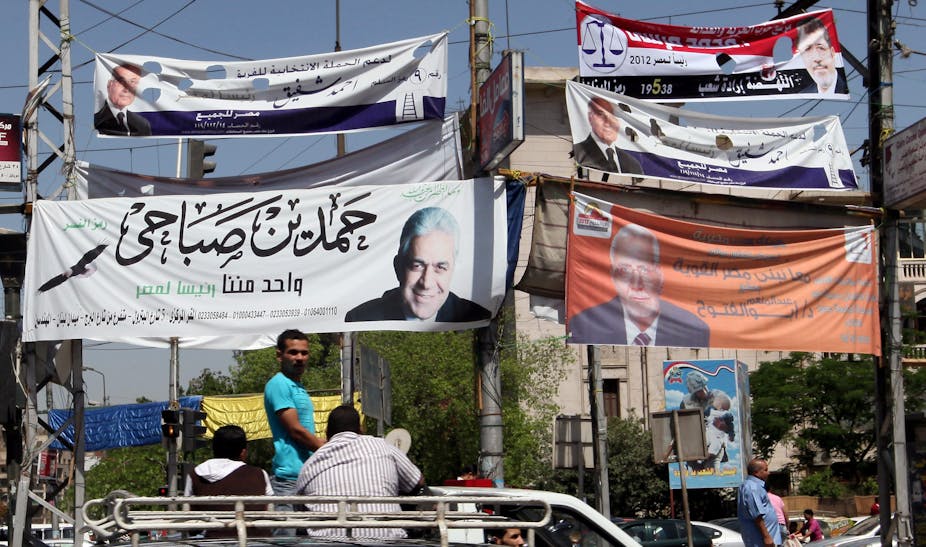In the face of the largest mobilisation Egypt has ever witnessed, President Hosni Mubarak stepped down on February 12, 2011. Facing an unlikely coalition of disaffected youth, labour workers, Islamists and army generals thinking of their own survival, Mubarak was forced out of power after a 30-year rule.
18 months on, the jubilation and euphoria of Egyptians celebrating in Tahrir Square has turned to despair, as the revolution has become caught between the military and the Islamists.
Over the next two days, Egyptians will vote for a new President to lead the country into its next era.
A shaky transition
Egypt’s ruling military junta, the Supreme Council of the Armed Forces (SCAF) has mismanaged the country’s transition to democracy, suggesting either incompetence or complacence. SCAF consists of 20 generals, all of whom were Mubarak’s comrades in arms.
It is led by Field Marshal Mohammad Tantawi, Mubarak’s Minister of Defence for 15 years. During the Egyptian uprising, SCAF claimed it was siding with the revolution, but evidence suggests SCAF has merely maintained its own interests.
Another force has seen a rise to prominence since the uprising. The Islamist sweep of the Egyptian parliament has caused fear within the secular-minded segment of the population, that the revolution will produce an Iranian model.
On the other hand, Islamists, emboldened by their electoral victory, have argued that they now enjoy legitimacy and carry a mandate from the electorate.
The secularists
The presidential candidate field highlights the dichotomy between Islam and secularism in Egypt. There are 13 candidates on the presidential ballot. While opinion polls have been notoriously inaccurate, only five of those 13 stand any true chance.
On the secular side, most notable is Amr Moussa, ex-Foreign Minister and ex-Arab League Secretary General, who enjoys genuine popularity, primarily due to populist stances during his time as Foreign Minister. However, he is seen by some in the revolutionary youth camp as too close to the old regime. His public positions regarding the military indicates that he will seek accord with the generals.
Ahmad Shafik, ex-aviation minister and close friend and confidant of Mubarak is audaciously running. Seen by some as the military’s preferred candidate, Shafik will be aiming to capture the vote of Egyptians unhappy by the economic and security situation that the revolution has created. Shafik is considered a key part of the old regime.
Hamdeen Sabahy is considered popular by some, but does not have the necessary name recognition to carry such a historic election. However, he remains popular with some of the youth of the revolution, where he is seen as progressive on social and economic issues, as well as his nationalistic rhetoric inspired by iconic 20th century President, Gamal Abdel Nasser.
The Islamists
On the Islamist side, there are two powerful contenders.
Ex-Muslim Brotherhood Abdel Monem Aboul Fotouh enjoys genuine popularity from Islamists and also from the secular forces, due to his progressive stance on various policy issues. However, his membership of the Muslim Brotherhood leadership for decades has caused suspicion that he is a mere Trojan horse for the Brotherhood. Also, the ultra-conservative Salafis have endorsed him as their preferred candidate, casting further doubt on his “progressiveness”.
Mohammed Morsi, the Muslim Brotherhood candidate, will of course directly benefit from its well oiled and financed political machine. He will be able to leverage on the strong support the Brotherhood enjoys in accessible remote areas, far away from the metropolises of Cairo and Alexandria.
The Brotherhood and the military: history runs deep
Since the 2011 uprising, there have been moments of accord and discord between the military and the Brotherhood, effectively the two most powerful organisations in Egypt.
The Egyptian political arena now is not dissimilar to the 1950s, when the Free Officers, some of whom had connections with the Brotherhood, overthrew King Farouk and assumed power. The Brotherhood and the Free Officers initially cooperated, but fell out in 1954 after Gamal Abdel Nasser consolidated his authority.
Following an alleged assassination attempt, Nasser moved to swiftly eradicate the Muslim Brotherhood within Egyptian politics, imprisoning and executing many Brotherhood figures and decimating its leadership.
The Brotherhood was able to stage a comeback after the rise to power of Anwar Sadat, when Sadat briefly eased the pressure on the Islamist political stream, hoping to have them act as a bulwark to the Nasserites and leftists. Sadat subsequently cracked down on the Islamists, leading to his assassination by the radical Islamist group Jamaa Islamiya in 1981.
During Mubarak’s era, though still formally banned and subjected to repressive measures, the Brotherhood maintained its renunciation of the use of violence and was able to operate cautiously, especially in the professional syndicates, eventually making unprecedented gains in the Egyptian parliamentary round of elections in 2005.
The revolutionary youth: where to from here?
The Muslim Brotherhood’s sweep of parliament has unsettled the revolutionary forces, personified by the youth of Tahrir Square and progressive left and secular liberal groups. They find themselves the weakest link in a power struggle between the generals and the sheikhs, led by the Muslim Brotherhood and the Salafists.
This is proof of the weakness of the youth of Tahrir, who were not able to consolidate their success in forcing Mubarak out of power in 2011 into solid political gains in 2012. They find themselves fighting on two fronts: against the military and the Islamists.
This failure is no more apparent than in the coming presidential elections where most of the leading candidates are remnants of the former regime facing off with the Islamists, with no single credible contender representing the youth of the revolution.
It is now up to the revolutionary forces to regroup and unite to face the generals and the sheikhs, before they are able to manufacture a new order that might look eerily similar to the one Mubarak presided over.
This is partially based on an article that will appear in the Bulletin of the Centre for Arabic and Islamic Studies (CAIS) at the Australian National University.

